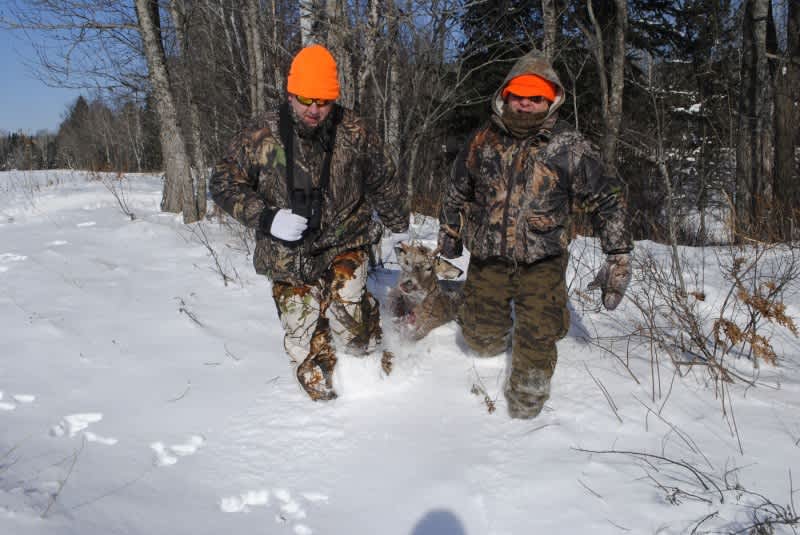Mi-HUNT Helps Sportsmen Find Places to Hunt in Michigan
Bob Gwizdz 12.02.15

Michigan’s 16-day firearms hunting season, which drew to a close November 30, may be in the rear-view mirror right now, but there’s still a lot of deer hunting opportunity ahead. Besides muzzleloader season, which attracts about 100,000 sportsmen and women, archery season continues through January 1. There’s plenty of deer season to go.
Although most hunters will continue to hunt the same ground they’ve pounded so far, hunters who have not seen a lot of whitetails may want to go elsewhere. And now, because of new tool the Department of Natural Resources (DNR) has made available, finding new hunting territory is a lot easier than it used to be.
Mi-HUNT is a web-based information system that shows hunters where to find more than 10 million acres of land available for public hunting across the state. The system includes all state and federal property open to hunting (including some state parks, though the state parks have their own rules, so make sure you know what they are before you get there).
There’s also a lot of private land—commercial forest and Hunter Access Program (HAP) land—where the public is welcome. Commercial forest land is largely forested land (generally found in Northern Michigan) where timber management is the main goal, which is enrolled in a DNR-run program that gives hunters access to the land in exchange for lower taxes on that property. HAP lands (which are largely found in Southern Michigan) are typically farm lands that are leased to the DNR for public hunting.
The Mi-HUNT system came online in 2010. It was developed by the DNR with a grant from the National Shooting Sports Foundation. It is constantly being updated as land is acquired or sold.
“The public loves it,” says Nick Dohm, a Geographic Information System analyst with the DNR’s Forest Resources Division, who helped design it. “Response has been very positive. The purpose of Mi-HUNT is to have a one-stop shopping center for hunters to access all of the available hunting land in Michigan.”
You can access the service immediately by clicking here. When the website comes up and you agree to some simple stipulations (primarily just a warning that the maps are not guaranteed to show legal boundaries), a map of Michigan pops up. On the map, you’ll see state game areas (red stars) and HAP lands (yellow stars). If those appeal to you, you can zoom in on them and find their identity—either name of the game area or the owner and address of the HAP property. You can also find out the specifics; some HAP lands, for instance, limit the type of hunting available (say small game only or youth hunters and mentors-only). You can find out how many hunters are allowed and what the check-in procedure is like. It’ll also provide a basic breakdown on what the property is like: forest, wetlands, croplands, by both acreage and percentage.
Hunters who prefer a specific area can begin by picking out a county or by going to GPS coordinates. Once they zoom in on an area, they have a choice of viewing three different types of maps: a road map, a hybrid map (which breaks down the area by various cover types), or a topographical map. Maps are printable and downloadable to a smartphone or tablet. The hybrid maps show nine different cover-types that are color-coordinated (oak, aspen, conifers, wetlands, and even rock and sand) and show tree densities (low, medium, and high) as well as the average size of the trees (sapling, pole, or log). If you want to hunt an oak ridge, for instance, you can find the oaks with the cover-type map and the ridges by the topographical map.
Aerial photographs of most of these areas are available as well.
“It’s my principal hunting tool,” said Mike Donovan, a resource specialist who works on GIS issues for the DNR Wildlife Division. “It’s very fruitful. It puts you in the landscape.”
Donovan says he downloads a map on his smartphone, then drops in a waypoint where he parks his truck so he can find his way around new territory.
Mi-HUNT features general information on the county in which you are going to hunt, including the availability of camping and lodging. There’s even a tool that will allow you to map out to route to get there from your home.
Mi-HUNT is not 100 percent foolproof. The DNR, for instance, only reinventories state forest lands every 10 years, so it’s possible that a timber sale and cut occurred that hasn’t been updated in the system by the time you get out there. But it will put you on land that is open to public hunting and get you in the vicinity of where you want to be. You’ll have to ground-truth what you find. But that’s part of hunting, isn’t it?
Michigan has always boasted bountiful public lands for hunters. Now, with Mi-HUNT, detailed information on those lands is available via laptop, tablet or even your smartphone on-demand.
For more information on Michigan hunting go to michigan.org. Click here to purchase a Michigan hunting license online.
This article was produced in partnership with Pure Michigan.

